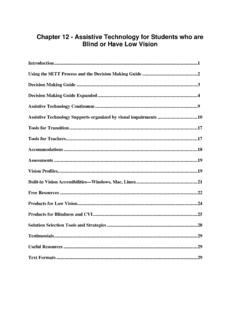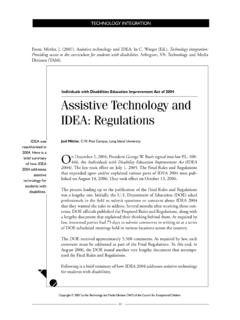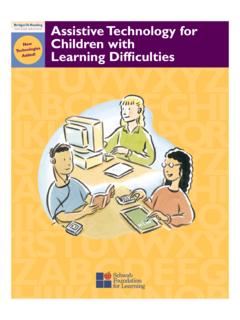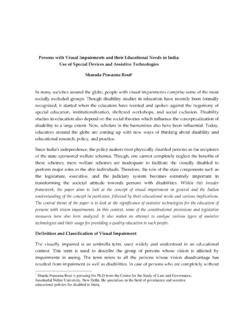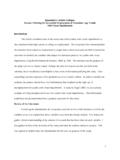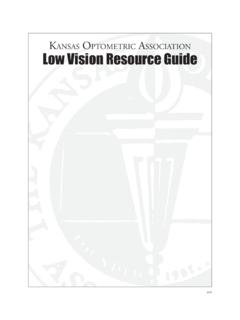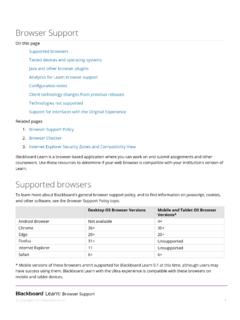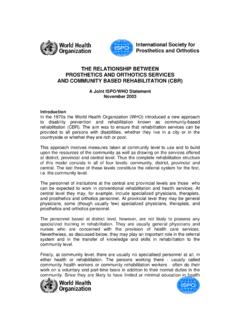Transcription of Chapter 1 – Assessing Students’ Needs for Assistive ...
1 Chapter 1 Assessing students Needs for Assistive technology (ASNAT) process Overview of Assessment and Planning process ..1 Using the AT Consideration Guide ..7 WATI AT Consideration Guide ..10 AT Assessment ..12 Assessing a Student s Needs for AT Where to Start? ..15 Gathering Information about the Student ..18 WATI Student Information Guide (Sections 1-12) ..22 Gathering Information about Environments and Tasks ..45 Using the AT Decision Making Guide ..52 Using the AT Checklist ..60 Additional Tools ..63 Implementing Trials with AT ..64 Products.
2 68 Chapter 1 Assistive technology Assessment Assessing students Needs for Assistive technology (2009) 1 Overview of the Assessment and Planning process Penny Reed, , Updated by Jill Gierach, MSE ATP This Chapter provides an overview of the Assistive technology consideration, assessment and planning process that has been implemented throughout Wisconsin and in hundreds of school districts across the country. The term assessment is being used rather than evaluation, except when specifically quoting IDEA. IDEA states that one of the Assistive technology services that a school district must provide is an Assistive technology evaluation.
3 However, throughout this manual, we will use the term assessment rather than evaluation , unless directly quoting the law. This is based on the following definition from the Federal Register (July 10, 1993). Evaluation: A group of activities conducted to determine a student s eligibility for special education. Assessment: A group of activities conducted to determine a student s specific Needs . (Italics added for emphasis.) We believe that assessment is a more accurate and descriptive term for what Needs to occur. It has long been our philosophical belief that there is no eligibility criterion for Assistive technology .
4 IDEA 97 supported that philosophy with its requirement that each IEP team consider the student s need for Assistive technology . This language remains in IDEA 04. The first page in this section contains the definition of Assistive technology devices and Assistive technology Services from IDEA. Following that is an explanation of the forms and process developed by the Wisconsin Assistive technology Initiative for both Consideration and Assessment . There are descriptions of the steps for information gathering, decision-making, and trial use. In addition, there are directions on how to use the specific forms for each step of the process .
5 All products mentioned in this Chapter appear in a table at the end of the Chapter along with the company that produces them. A list of products and companies is at the end of the each Chapter of this manual. Each of the forms contained in this Chapter are included in the appendix as reproducible forms. These may be copied for your use if you maintain the credits as they appear on each page. Chapter 1 Assistive technology Assessment Assessing students Needs for Assistive technology (2009) 2 Assistive technology Laws Affecting School Districts As stated in , each school district is required to insure that Assistive technology devices and services are provided if needed by a student in order to receive a free appropriate public education (FAPE).
6 Definition of Assistive technology Assistive technology Each public agency shall ensure that Assistive technology devices or Assistive technology services or both, as those terms are defined in - are made available to a child with a disability if required as a part of the child s (a) Special education under ; (b) Related services under ; or (c) Supplementary aids and services under (b)(2). Assistive technology devices and services Assistive technology device. Assistive technology device means any item, piece of equipment, or product system, whether acquired commercially off the shelf, modified, or customized, that is used to increase, maintain, or improve the functional capabilities of a child with a disability.
7 The term does not include a medical device that is surgically implanted, or the replacement of such device.(Authority: 20 1401(1)) Assistive technology services Any service that directly assists a child with a disability in the selection, acquisition, or use of an Assistive technology device. Such term includes: (A) the evaluation of Needs including a functional evaluation, in the child s customary environment; (B) purchasing, leasing or otherwise providing for the acquisition of Assistive technology devices; (C) selecting, designing, fitting, customizing, adapting, applying, maintaining, repairing, or replacing of Assistive technology devices; (D) coordinating and using other therapies, interventions, or services with Assistive technology devices, such as those associated with existing education and rehabilitation plans and programs.
8 (E) training or technical assistance for a child with disabilities, or where appropriate that child s family; and (F) training or technical assistance for professionals (including individuals providing education and rehabilitation services), employers or others(s) who provide services to employ, or are otherwise, substantially involved in the major life functions of of that [Authority: 20 1401(2)) Chapter 1 Assistive technology Assessment Assessing students Needs for Assistive technology (2009) 3 The reauthorization of IDEA 04 aligned with laws found in No Child Left Behind (NCLB).]
9 One such alignment was in the identification of the need to provide alternative text formats to students who had difficulty interacting with text found in standard core content text books. This law impacts Assistive technology tool choice as well as the delivery of services. IEP teams must identify the text format that matches a student s need. Additionally, they must select the compatible file format for the device the student will use and the service needed to support the student in accessing these correct files. (a)(1) Adopt the National Instructional Materials Accessibility Standard (NIMAS), published as appendix C to part 300, for the purposes of providing instructional materials to blind persons or other persons with print disabilities, in a timely manner after publication of the NIMAS in the Federal Register on July 19,2006 (71 FR 41084).
10 Consideration IDEA 97 added the requirement that each IEP Team consider the need for Assistive technology as part of the Consideration of Special Factors. (a)(2) Consideration of Special Factors. The IEP Team (v) consider whether the child requires Assistive technology devices and services. Lack of Guidelines Neither the law nor the regulations provided guidelines for school districts in the implementation of these requirements. This may be part of the reason that school districts still struggle to comply with the laws relating to Assistive technology .
